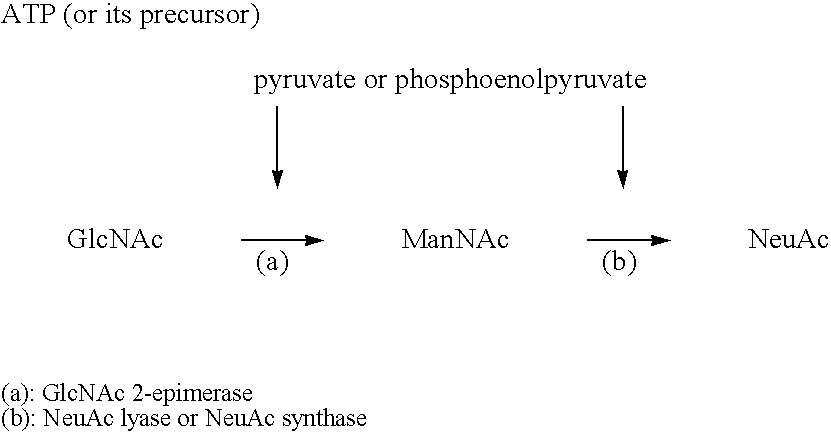Process for producing cmp-n-acetylneuraminic acid
a technology of acetylneuraminic acid and process, which is applied in the direction of sugar derivates, lyases, transferases, etc., can solve the problems of high cost of cmp-neuac, cumbersome steps, and large-scale facilities, and achieve high yield and high yield
- Summary
- Abstract
- Description
- Claims
- Application Information
AI Technical Summary
Benefits of technology
Problems solved by technology
Method used
Image
Examples
example 1
(1) Cloning of nanA gene encoding N-acetylneuraminic acid lyase
[0048] Chromosomal DNA (ATCC 51907D) of Haemophilus influenzae (H. influenzae) Rd strain was used as a template, and the two below-described primer DNA sequences were synthesized according to a method known per se. The N-acetylneuraminic acid lyase (nanA) gene of H. influenzae was amplified through PCR.
Primer (A):(SEQ ID NO: 1)5′- CACCATGGCGAAGATATTGCCGCTCAAACTA -3′Primer (B):(SEQ ID NO: 2)5′- CCGAATTCATTTATGACAAAAATTTCGCTTTCAAG -3′
[0049] Amplification of the nanA gene through PCR was performed in a DNA Thermal Cycler (product of Perkin-Elmer Cetus Instrument) by adding thereto a 100 μL reaction mixture containing 50 mM potassium chloride, 10 mM Tris HCl (pH 8.3), 1.5 mM magnesium chloride, 0.001% gelatin, 0.1 μg template DNA, DNA primers (A) and (B) (each 0.2 μM), and AmpliTaq DNA polymerase (2.5 units). The cycling protocol consisted of 25 cycles of the following three steps: strand denaturation at 94° C. for 1 min...
example 2
(1) Cloning of neuB1 gene encoding N-acetylneuraminic acid synthase
[0075] Chromosomal DNA of Campylobacter jejuni 1652 strain was used as a template, and the two below-described primer DNA sequences were synthesized according to a method known per se. The acetylneuraminic acid synthase (neuB1) gene was amplified through PCR.
(SEQ ID NO: 9)Primer (I):5′- TACGATTATTTTCCTGATGCTC -3′(SEQ ID NO: 10)Primer (J):5′- TCTCCAAGCTGCATTAAACGCC -3′
[0076] Amplification of the neuB1 gene through PCR was performed in a DNA Thermal Cycler (product of Perkin-Elmer Cetus Instrument) by adding thereto a 100 μL reaction mixture containing 50 mM potassium chloride, 10 mM Tris HCl (pH 8.3), 1.5 mM magnesium chloride, 0.001% gelatin, 0.1 μg template DNA, DNA primers (A) and (B) (each 0.2 μM), and AmpliTaq DNA polymerase (2.5 units). The cycling protocol consisted of 30 cycles of the following three steps: strand denaturation at 94° C. for 1 minute, annealing at 55° C. for 1.5 minutes, and polymerization ...
PUM
| Property | Measurement | Unit |
|---|---|---|
| Mass | aaaaa | aaaaa |
| Mass | aaaaa | aaaaa |
Abstract
Description
Claims
Application Information
 Login to View More
Login to View More - R&D
- Intellectual Property
- Life Sciences
- Materials
- Tech Scout
- Unparalleled Data Quality
- Higher Quality Content
- 60% Fewer Hallucinations
Browse by: Latest US Patents, China's latest patents, Technical Efficacy Thesaurus, Application Domain, Technology Topic, Popular Technical Reports.
© 2025 PatSnap. All rights reserved.Legal|Privacy policy|Modern Slavery Act Transparency Statement|Sitemap|About US| Contact US: help@patsnap.com



